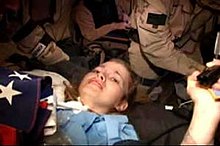Women in the military in the Americas
This article is about the role played by women in the military in the Americas, particularly in the United States and Canada from the First World War to modern times.
Maria Quitéria de Jesus fought for the maintenance of the independence of Brazil, and is considered the first woman to enlist in a military unit.
After the war, as well as the rest of the FEB, the nurses, most have been awarded, they won the official patent and licensed the active military service.
The Army established the Military Female Volunteer for Medical, Dental, Pharmaceutical, Veterinary and top-level Nurses (MFDV) in 1996.
At that time, he entered the first class of 519 women lawyers, administrators of businesses, accountants, teachers, computer analysts, engineers, architects, journalists, and other areas of human and exact sciences, serving the needs of Official Temporary Technical (OTT) of Institution.
Canadian women were also organized into possible uniformed home guard units, undertaking military training in paramilitary groups.
As well, 45,000 women served as support staff in every theatre of the conflict, driving heavy equipment, rigging parachutes, and performing clerical work, telephone operation, laundry duties and cooking.
1981 saw the first female navigator and helicopter pilot, and in 1982 laws were passed ending all discrimination in employment, and combat related roles in the Canadian armed forces were opened for women, with no restrictions in place, with the exception of the submarine service.
[1] According to the Virginia General Assembly, "in the revolutionary war, in the garb, and with the courage of a soldier, [Lane] performed extraordinary military services, and received a severe wound at the battle of Germantown.
[citation needed] This corps was formed in 1917 from a call by General John J. Pershing to improve the worsening state of communications on the Western front.
Applicants for the Signal Corps Female Telephone Operators Unit had to be bilingual in English and French to ensure that orders would be heard by anyone.
Not until 1978, the 60th anniversary of the end of World War I, did Congress approve veteran status and honorable discharges for the remaining women who had served in the Signal Corps Female Telephone Operators Unit.
They served stateside in jobs and received the same benefits and responsibilities as men, including identical pay (US$28.75 per month), and were treated as veterans after the war.
Wartime newspapers erroneously reported that twin sisters Genevieve and Lucille Baker were the first women to serve in the Coast Guard.
[12] Women who served during WWI were demobilized when hostilities ceased, and aside from the Nurse Corps the uniformed military became once again exclusively male.
There were 350,000 American women who served during World War Two and 16 were killed in action; in total, they gained over 1,500 medals, citations and commendations.
However, it is recorded that 600 women served in the country as part of the Air Force, along with 500 members of the WAC, and over 6,000 medical personnel and support staff.
[16][17] In 1974, the first six women aviators earned their wings as Navy pilots: Jane Skiles O'Dea, Barbara Allen Rainey, Rosemary Bryant Mariner, Judith Ann Neuffer, Ana Marie Fuqua, and Joellen Drag Oslund.
That is not to say that they were the first females in combat because, as above illustrates, women have fought the front lines, whether they were afforded official Congressional recognition for their service or not.
[23] During the Battle of Nasiriyah in 2003, American soldiers Shoshana Johnson, the first African-American and first Hispanic female prisoner of war, and Jessica Lynch were captured while serving in Iraq.
In the same action, Lori Piestewa, a U.S. soldier, died after driving her Humvee through enemy fire in an attempt to escape an ambush, earning a Purple Heart.
Also in 2003, Major Kim Campbell was awarded the Distinguished Flying Cross for landing her combat damaged A-10 Thunderbolt II with no hydraulic control and only one functional engine after being struck by hostile fire over Baghdad.
In 2005 SGT Leigh Ann Hester became the first woman to receive the Silver Star, the third-highest US decoration for valor, for direct participation in combat.
The squad leader, SSG Timothy Nein, had originally received the Silver Star, but his award was later upgraded to the Distinguished Service Cross.
In Afghanistan, Monica Lin Brown was presented the Silver Star for shielding wounded soldiers with her body, and then treating life-threatening injuries.






